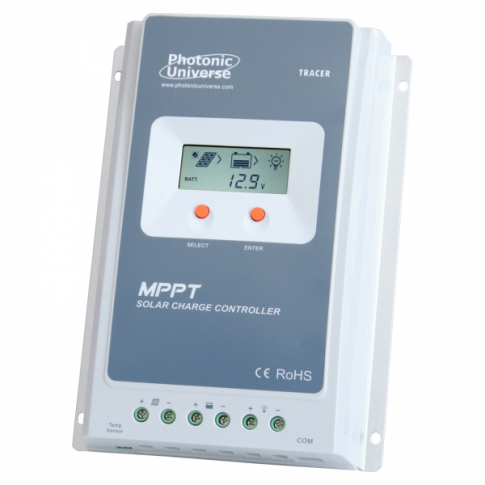MPPT Technology:
This solar charge controller uses the most advanced Maximum Power Point Tracking (MPPT) technology to track the maximum power voltage point of solar panels as it varies depending on sunlight exposure and temperature. This technology ensures the maximum efficiency of your solar system and significantly outperforms standard PWM solar controllers. Another benefit of MPPT technology is the wide solar input voltage range – this controller can work not only with standard off-grid 12/24V solar panels, but also with multiple panels with voltage up to 100V. The maximum combined input solar power allowed for this controller is 520W for a 12V battery system or 1040W for a 24V system. In particular, this controller will significantly increase efficiency of a solar system where the solar panel voltage is much higher than the battery voltage (e.g. charging a 12V battery with a 36V solar panel).
Full system protection:
This charge controller features a comprehensive set of electronic protection functions to ensure the maximum possible efficiency of your solar system. These include: reverse current prevention at night (from the battery back to the solar panel), automatic cut off to prevent over-charging and deep discharge, solar panel over voltage, over load, short circuit and reverse polarity protection. The controller also has self-diagnostic capability and highlights any system errors using advanced fault-targeting technology.
Lithium Battery charging:
This solar charge controller is compatible with lithium batteries when a lithium battery charging program is selected using PC software or mobile app (see below for more details).
Advanced system monitoring:
- The controller automatically recognises 12/24V battery systems (note a battery should always be connected to the controller first before connecting a solar panel)
- Built-in LCD screen shows real-time charging parameters such as voltage, current (separately for solar panel / load), battery state of charge, accumulated charge and discharge energy
- Easy to use buttons allow the user to manually select the battery type (sealed, flooded or gel) and program load settings (e.g. set timers for lighting, fans, pumps etc).
- Current limiting function (10A) allows the possibility of adding more solar panels to your solar system in the future
Multiple connectivity options:
This model also features advanced communication technology, which offers the user the opportunity to monitor and program parameters for the solar charge controller through various methods:
1) The controller can be connected to a remote meter MT50 with an LCD screen, which displays system performance information and allows the user to manually adjust parameters and load settings
2) The controller can be connected to a Wi-Fi module to create a Wi-Fi network, to which your mobile phone or tablet can connect, in order to monitor or adjust charging parameters and controller settings through a free mobile app (available for Android and iOS users), including setting the charging parameters for lithium batteries.
3) An RJ45 to USB cable can be used to connect the controller directly to your PC / laptop, where parameters and settings can be monitored and adjusted via a free computer program – Solar Station Monitor (Windows-based PCs and laptops only). If using the RJ45 to USB cable, the user also has the option to create a user-defined battery type with charging parameters specific to their battery (if the pre-existing options are unsuitable), and can also set the charging parameters for lithium batteries.
Using one of these communication methods, the user will gain access not only to the standard charging parameters already shown via the built-in LCD screen, but also additional information such as min/max voltages, temperature, protection cut off voltages, diagnostics and other information. If required the user will also be able to amend the battery capacity, set charging volts for different charging stages, specify the duration of each charging stage, create a user-defined battery type with charging parameters specific to their battery (if the pre-existing options are unsuitable), and more.
In addition to the built-in temperature sensor and intelligent heat-dissipating design of this controller, there is also a socket for connecting a remote temperature sensor, which can be attached directly to the battery to measure the battery temperature more precisely and optimise the charging process. (Inbuilt temperature sensor is not enabled for lithium batteries).





